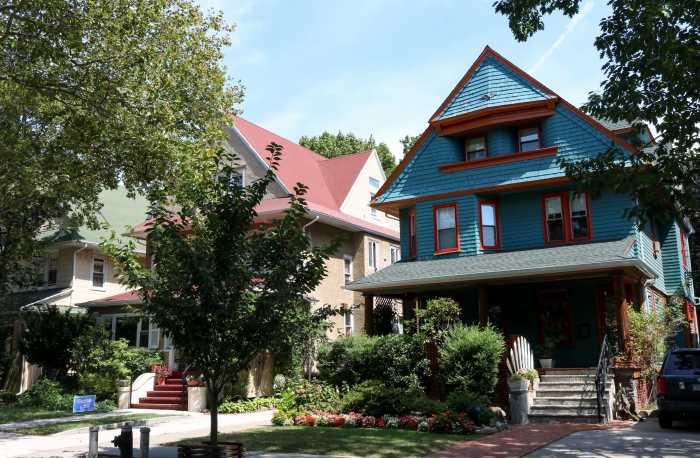It opened to great fanfare in 1916 but it has been decades since the movie lights flickered inside the Rialto Theatre in Flatbush.
Purchased by a congregation in the 1970s for use as a worship space, a recent look inside the modest brick building at 1085 Flatbush Avenue shows that bits of its theatrical past can still be found. Columns, pilasters and stylized flowers dot the auditorium that originally fit about 2,000 movie watchers.
This wasn’t one of the over-the-top movie palaces with statement-making exteriors and interiors dripping with lavish details. At first glance the exterior, designed by R. Thomas Short, appears relatively modest. But the white paint that has covered the building since at least the early 1980s disguises a finely detailed tapestry brick facade that includes a lyre and theatrical masks ornamenting the pediment. The original iron and glass marquee and signage depicted in early photos was replaced with a larger marquee by the late 1930s, as seen in the historic tax photo; it too is now gone.


We did not uncover any early photos of the auditorium, but reviews of the local press and trade publications provided some clues about the original details. “The interior of the Rialto is chiefly distinctive for its good taste rather than elaborate detail of its decoration,” the Standard Union reported just a few weeks before the theater opened on March 18, 1916.
Other design elements highlighted in local papers were a lobby with marble floors, mirrors and plasterwork ornamenting the ceiling. The auditorium was lit with gold chandeliers. The Brooklyn Daily Eagle was the only publication to refer to the ornament as being designed with an “Egyptian idea” with a gold and white theme and a “sprinkling of red, green and blue blended into the ceiling and wall panels.”

While the multi-hued finishes are gone, a gold and white theme is still used on the interior. Gold paint picks out wall moldings, pilasters and the arabesque ornaments that flank the wall sconces. The most striking detail, and one that seems perhaps the most likely to be original, are the stylized sunflowers that top four of the pilasters flanking the stage.

What was unusual about the Rialto, at least according to the press at the time, was that while there was room for an orchestra there was not a full setup for vaudeville or stage productions. The owners were betting on the new power of motion pictures alone to lure audiences to their new venue. The new theater would focus on “high class photoplay exhibition,” the Motion Picture News proclaimed in 1916, with musical selections before and after the film and an orchestra to provide accompaniment to the silent films.
That bet on the power of film seemed to pay off if opening night was any indication. Crowds stormed the doors on March 18, 1916, reported the Brooklyn Daily Eagle, eager to see the new theater and the opening attraction of “The Ne’er Do Well” a multi-reel saga based on a novel by Rex Beach.
The theater managed to entertain Flatbush audiences until 1976, according to Brownstoner’s Suzanne Spellen, when 60 years of showing popular films came to an end. The building stayed in active use as a church although the current congregation, the Cortelyou Road Church of God, is looking for a new tenant for a substantial part of the building, including the massive auditorium.
This story first appeared on Brownstoner.

























